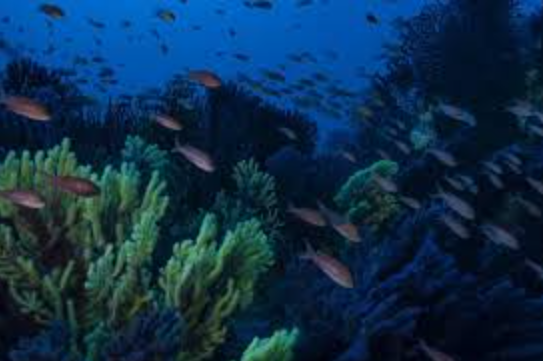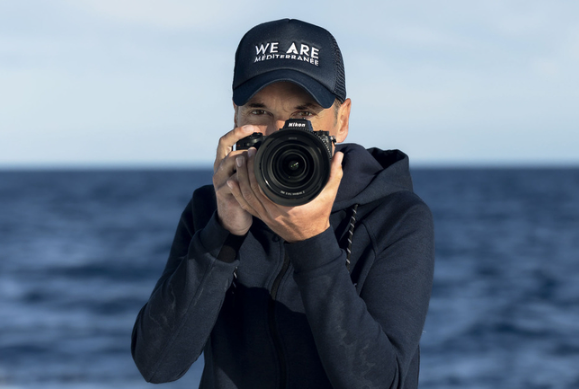In the Var, a collective of fishermen is managing a designated marine area left fallow to allow biodiversity to thrive—a model that benefits both marine life and artisanal fishers.
It is a deep, salty haven, one that can’t be discovered without gills or diving skills. To picture it, one must rely on the memories of those lucky enough to explore it, with tanks strapped to their backs. “It’s like a cornucopia,” enthuses photographer and marine explorer Alexis Rosenfeld. “I wish I could have taught Monet to dive so I could bring him here. I think after that, he would have struggled to choose between the sea and his garden.”
This place is the Cap Roux fishing reserve, a 445-hectare stretch of water, Posidonia seagrass beds, and rocky reefs at the foot of the Estérel massif (Var). Fishing is strictly forbidden here. Groupers, dentex, sea bream, and barracudas thrive, swirling in plump schools among clusters of scarlet gorgonians. « There are plenty of fish, big ones, and they aren’t shy, » describes Muriel Verrier, secretary of the nearby Agay diving club and marine biology instructor.
The unique feature of this place: it was the fishermen themselves who collectively decided, in 2003, to ban fishing there, allowing marine biodiversity to flourish—a first for the country. For nearly twenty-one years, the area has been self-managed by the twenty or so fishermen who work nearby, organized within the fishing guild of Saint-Raphaël. “The fishermen sacrificed part of their revenue to protect the resource,” notes Olivier Bardoux, an artisanal fisherman and member of the Saint-Raphaël guild.
The initiative arose alongside the creation of the first marine protected areas. “We started hearing about plans for Natura 2000 zones at sea and regional marine parks,” recalls Christian Decugis, professional fisherman and the first chief of the Saint-Raphaël guild. “These usually come from higher up and aren’t tailored to the local context. We thought, if it’s going to happen, we might as well propose a zone ourselves rather than have one imposed on us from an office in Paris.”
Cap Roux quickly emerged as the ideal location. “It’s an area exposed to bad weather, so we only went there when conditions were good. If the reserve had been right in front of the port, it would have blocked 60 or 70% of our working time. But it’s not a worthless area either—not some polluted gulf where nothing has ever lived and never will!” insists Christian Decugis. “It’s a very beautiful and abundant zone.”
“To offset the revenue loss, we adapted our way of working”
Inevitably, the project faced some objections from fishermen who frequented this part of the Mediterranean most. “But the majority supported it,” says Christian Decugis. This support can be attributed to the adaptability and versatility of the small-scale Mediterranean fishermen who make up the Saint-Raphaël guild.
“We adjust with the times, gathering a bit from each resource,” explains Olivier Bardoux. “To offset the revenue loss, we adjusted our work methods, techniques, and fishing areas.” In Brittany, where industrial fishing is more prevalent, such an initiative might face more hurdles, according to Maud Maury, an advocacy officer with the ocean conservation group Bloom.
Even today, most members of the Saint-Raphaël guild support the existence of the Cap Roux fishing reserve: last April, they renewed the prohibition on capturing marine species in the area for another ten years. “There are always voices that would like to see the reserve reopened,” observes Olivier Bardoux. “But in the collective mindset, there’s no turning back for now.”
The direct involvement of fishermen is one of the main advantages of this model, according to Maud Maury. “A marine protected area established by fishermen is more likely to be accepted by the industry,” she explains. This reduces the risk of professionals widely circumventing capture prohibitions.
The benefits can be twofold. For the finned and scaled inhabitants of Cap Roux, the absence of nets is life-saving. “When there is no fishing mortality in an area, the fish can grow,” explains Joachim Claudet, a research director at CNRS and a specialist in marine protected areas. “These are unique animals that never stop growing. The bigger they get, the more eggs and larvae they produce. So, they reproduce more.”
“Fishermen can have better catches around these marine protected areas.”
Leaving part of the sea fallow can also benefit fishermen. Scientific literature shows that the biomass thriving in no-catch areas can overflow beyond their boundaries. “Normally, fishermen can have better catches around these marine protected areas,” observes Joachim Claudet. Is it possible to reconcile the end of the world with the end of the month? “There is a real need for education among fishermen about the benefits of marine protected areas,” estimates Maud Maury.
According to fisherman Olivier Bardoux, such reserves could one day open the door to a “diversification” of the profession: “In the future, I believe fishermen will become something like ‘multicard’ operators of the sea, earning their income from both fishing and collaboration with scientists.”
Off the coast of Saint-Raphaël, in the Mediterranean, this researcher from the LECOB-CNRS laboratory is collecting samples of red gorgonians (Paramuricea clavata). © Alexis Rosenfeld / Unesco Mission
Members of the Saint-Raphaël guild have already participated in several collection campaigns, as well as short monitoring missions for pay. “It’s interesting, both philosophically and economically,” says Olivier Bardoux.
However, the model is still improvable, according to scientists. For a reserve to have real benefits for biodiversity, it must be intended to remain closed—not to serve as a “fridge” where fishermen can harvest fish when their numbers increase, says Joachim Claudet: “When you reopen them to fishing, the effects are immediately nullified.”
“If we had subsidies, we could implement sustainable plans.”
The researcher observed this in Melanesia, where similar systems, known as “rahui,” exist. “Fish become easier to catch because they forget to fear fishing gear. In one day, we find ourselves back at the same level as outside the protected area.” For now, the Saint-Raphaël guild aspires to keep Cap Roux closed. To be effective, it must remain so over the long term, according to the researcher.
Another limitation is the lack of budget allocated for managing the reserve, and thus monitoring potential poachers. Due to its self-managed status, Cap Roux receives virtually no funding from the state, unlike other marine protected areas. “We lack resources,” laments Olivier Bardoux. “That’s where the problem lies. If we had subsidies, we could implement sustainable plans for fishermen to invest long-term in the reserve and monitor it.”
Details of a gorgonian exhibiting both purple and yellow hues. In the Mediterranean, this coral is threatened by anthropogenic and climatic pressures. © Alexis Rosenfeld / Unesco Mission
The artisan fisherman has noticed that due to ignorance of the rules—or deliberate intent to defraud—“there are always some people who fish a little” in the area, particularly recreational boaters. Although rare, these catches could hinder the effectiveness of the reserve, according to Italian researcher Antonio Di Franco, who has participated in numerous studies on Mediterranean marine protected areas, including Cap Roux. “Its potential is very high, but it hasn’t been fully realized,” he estimates. “If the reserve had a substantial budget and dedicated personnel, it is very likely that its ecological benefits would be much more pronounced than they are now.”
“They should be integrated into zones reserved for artisanal fishing.”
This type of reserve could benefit from being replicated elsewhere in France, according to Swann Bommier, advocacy manager at Bloom. However, for them to “truly” reconcile ocean protection and social justice, they should be part of a broader network of marine protected areas. “They need to be included in zones reserved for artisanal fishing,” he believes. “This would allow coastal artisanal fishermen to benefit from the overflow effect without that effect being siphoned off by industrial fishing.”
On a global scale, he explains, it is common for industrial vessels—well aware of the benefits of no-catch zones—to fish right at their borders. In this scenario, it is rare for artisanal fishermen to support these zones in the long term since they gain no benefit from them.
In both French and global waters, the extent of marine areas that are genuinely protected from fishing still leaves much to be desired. © Alexis Rosenfeld / Unesco Mission
“The government needs to do what it has been asked to do for years, which is to establish real marine protected areas,” repeats the subject specialist. On paper, France protects more than 30% of its waters. However, only a fraction is genuinely safeguarded from industrial fishing.
In the Mediterranean, the regulations for 95% of “protected” marine areas are the same as those for unprotected zones, according to a 2020 study published in the scientific journal One Earth. Only 0.23% of marine protected areas are reserved for the least aggressive techniques (such as spear fishing or line fishing) or strictly prohibited from fishing, as is the case at Cap Roux.
Source: reporterre



